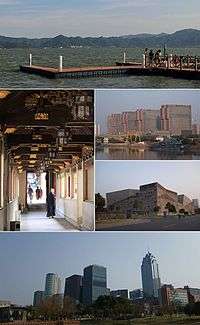Yinzhou District, Ningbo
| Yinzhou 鄞州区 | |
|---|---|
| District | |
|
Clockwise from the top: Dongqian Lake, Hefeng Creation Plaza, Ningbo Museum, Ningbo South Business District, Ningbo Ashoka Temple | |
 Yinzhou District in Ningbo Municipality | |
 Ningbo Municipality in China | |
| Country | China |
| Province | Zhejiang |
| Prefecture | Ningbo |
| Time zone | China Standard (UTC+8) |
| Website | www.nbyz.gov.cn |
Yinzhou (Chinese: 鄞州; pinyin: Yínzhōu) is a district of Ningbo in Zhejiang province, China.
History
In 220 BC, Qin Shi Huang, the first emperor of the Qin Dynasty, established three counties called Yin(鄞), Mao(鄮) and Gouzhang (句章).[1] Later they were merged into Gouzhang county during the Sui Dynasty. It was renamed Mao county during the Tang Dynasty. It had assumed its current name of "Yin" in the Five Dynasties and Ten Kingdoms period. The city of Ningbo was administrated by Yin county until after the establishment of the People's Republic of China. At the same time, Yin county became a county of Ningbo city. On Apr. 19, 2002, it was renamed Yinzhou District. It is one of the few counties that has kept the same name since its establishment more than 2000 years ago.
Historical personalities
- Cheng Duanli, educator
- Tong Dizhou, embryologist
Tourism
- East Zhejiang Maritime Affairs and Folk Customs Museum, housed in a former temple of Mazu and guildhall in central Ningbo, preserves the area's rich history of traditional arts and maritime trade.
- Liangzhu Cultural Park (梁祝文化公园) was built to commemorate the beautiful love story of Liang Shanbo and Zhu Yingtai. The story is based on the Chinese legend of the Butterfly Lovers.
- Tiantong Scenic Spot (天童风景名胜区) mainly consists of Tiantong Temple and Tiantong National Forest Park. Tiantong Temple is one of the most important Zen Buddhist temples; Sōtō began its formation there under Rujing. It was originally built during the Western Jin Dynasty around 300 AD (some date it between 265-316). It ranks second among the five sacred Chinese Zen Buddhist mountains. A very large complex of buildings, its former total of 999 rooms has now shrunk to 730 today, arranged in twenty groups of buildings rising up the mountain slope.
- Eyuwang Temple (阿育王寺) was built in A.D. 232. It is the only existing temple named after Ashoka in China.
- Dongqian Lake lies in the southeast of Yinzhou District. It is the largest natural freshwater lake in Zhejiang province, with a water surface area of 20 square kilometers. Since ancient times, the Lake has been a famous scenic spot in Eastern Zhejiang.
Industry
Yinzhou District is home to more than 15,000 industrial organizations. The economy mainly consists of six sectors: light textiles, garments, machinery, electronics, automobile parts and food. In 2008, its GDP reached RMB 65.08 billion yuan and per capita GDP reached RMB 82,052 yuan (US$11,815). Its imports and exports totaled US$1.44 billion and US$6.6 billion, respectively.
External links
References
Coordinates: 29°48′26″N 121°33′47″E / 29.80722°N 121.56306°E
